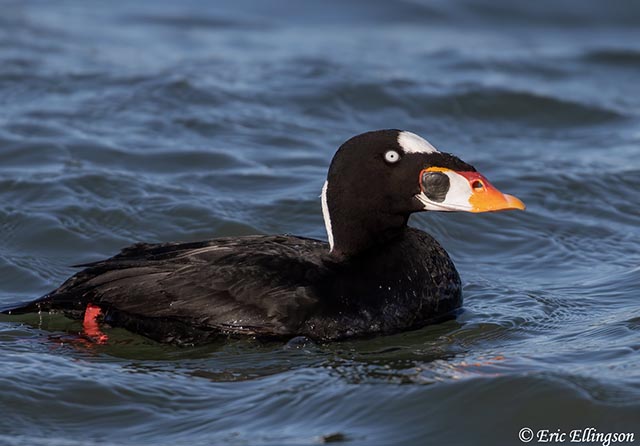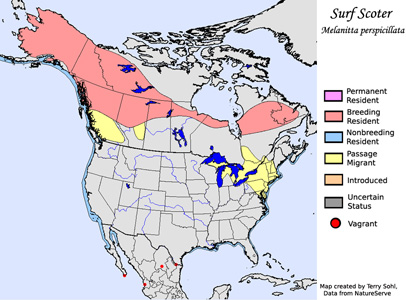| Length: 17 to 21 inches | Wingspan: 30 to 36 inches | Seasonality: Rare migrant |
| ID Keys: Black overall with white patches on head, orange and white on bill. | ||
 The
Surf Scoter is often referred to as "skunk-head coot" by hunters, a reference to
the male's strong black and white head patterning. They are most often
observed along both the Atlantic and Pacific coasts, where they can be quite
common. Small numbers over-winter on the Great Lakes every year, but they
are rarely found on other inland water bodies.
The
Surf Scoter is often referred to as "skunk-head coot" by hunters, a reference to
the male's strong black and white head patterning. They are most often
observed along both the Atlantic and Pacific coasts, where they can be quite
common. Small numbers over-winter on the Great Lakes every year, but they
are rarely found on other inland water bodies.
Habitat: Breeding habitat is around lakes and slow-moving rivers in Canada and Alaska, primarily in semi-open terrain. Primarily found in shallow coastal waters during winter, with small numbers wintering on the Great Lakes. They are only very rarely found inland on other water bodies in winter.
Diet: Primarily feeds on mollusks. Also will feed on crustaceans, small fish, marine worms, aquatic insects, and aquatic plants.
Behavior: A diving duck, feeding by diving underwater and propelling itself by its feet.
Breeding: Non-breeder in South Dakota
Song: Often silent, but the male will whistle and make low croaks during courtship.
Migration: Summers throughout much of Canada and Alaska. Winters along both the Atlantic and Pacific coasts of North America. Only a rare migrant in South Dakota.
Interactive eBird map: Click here to access an interactive eBird map of Surf Scoter sightings
Similar Species: Black Scoter, White-winged Scoter
Conservation Status: Numbers took a serious dive in the early 20th century, but populations have since rebounded. They are found across a broad geographic area and are common in some areas, but numbers are again apparently in decline. However, the decline is not currently worthy of listing, and the IUCN considers the Surf Scoter to be a species of "Least Concern".
Further Information: 1) USGS Patuxent Bird Identification InfoCenter, Surf Scoter
3) Audubon Guide - Surf Scoter
Photo Information:
Photo courtesy of Eric Ellingson
| Click on the map below for a higher-resolution view |
 |
| South Dakota Status: Rare migrant in the state. |
Additional Surf Scoter Photos (coming soon!)
